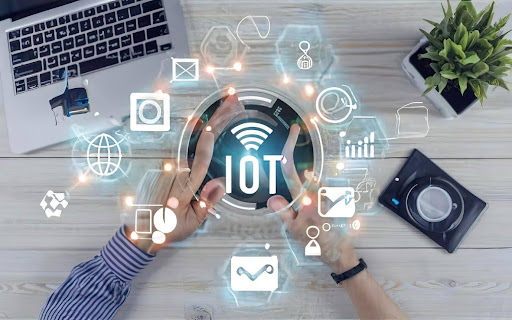Language of Things: Essential IoT Protocols for a Connected Future

The Internet of Things (IoT) is transforming how we live and work. Everyday objects, ranging from your thermostat to massive factory machines, are now connected and can communicate seamlessly.
Now imagine your coffee maker ordering beans before you run out or streetlights dimming to save energy—the exciting potential of the Internet of Things. The foundation of this connected revolution is a set of specialized protocols, which this post will discuss.
Understanding these protocols is critical for anyone developing, deploying, or managing IoT solutions to ensure their scalability, security, and efficiency.
Let us take a quick look at the IoT landscape first. The following are the industries that IoT covers:
- Smart Homes: Control your home environment with a tap on your phone.
- Healthcare: Monitor patient health remotely with wearable devices.
- Agriculture: Optimize crop yields using sensors and data analytics.
- Industry: Increase efficiency with machines that predict maintenance needs.
The magic of IoT lies in its ability to seamlessly integrate into the devices we use daily, often without us even noticing.
As you learn more about IoT protocols, remember they are not just about gadgets. They are about building a network where information flows freely, increasing efficiency and creating new opportunities. According to IHS, by 2025, over 75 billion IoT devices are expected to be worldwide. That is a lot of intelligent discussion!
Why Do We Need IoT Protocols?
Consider a world where your smartwatch, home thermostat, and car all communicate in the same language. This is what interoperability is all about. It forms the foundation of a truly connected IoT universe. Without it, the promise of the Internet of Things falls apart. Devices and systems must have data interoperability to exchange data and understand each other to work in harmony. This is where the Connectivity Standards or the IoT Protocols come into play.
The table below is a quick review of how IoT resolves interoperability:
| Challenge | Solution |
| Fragmented IoT landscape | Adopt common standards |
| Lack of standardization | Collaborate on protocols |
| Scalability issues | Certify interoperable devices |
Ensuring interoperability allows devices to interact seamlessly without any interruption, regardless of the manufacturer. This simplifies the user experience and opens doors to innovation and more intelligent living.
Think of these protocols as creating a common language for IoT devices. This effort can lead to a more integrated and efficient IoT ecosystem, where devices connect and cooperate to unlock new applications and achieve shared goals.
Key IoT Protocols
The Internet of Things (IoT) ecosystem depends on various protocols to enable smooth device communication. Let us examine more closely some of the most popular choices:
i. Message Queuing Telemetry Transport (MQTT)
This protocol is the best choice when working with low-bandwidth networks and devices with constrained power and memory. It is a simple publish/subscribe system. Imagine it like a bulletin board, where users can post updates and others can browse just the information they are interested in seeing. MQTT is perfect for remote monitoring, controlling smart home appliances, and sending sensor data.
ii. Constrained Application Protocol (CoAP)
Simplifies the well-known HTTP protocol for use in networks with limited resources. Due to its similar request/response paradigm, it is easy for developers to work with. CoAP is particularly effective in scenarios where devices must be able to be found and controlled over a network, like industrial automation and smart buildings.
iii. HTTP/REST
The web’s enabling protocols may impact the Internet of Things. HTTP/REST provides a flexible and well-understood means of exchanging data for applications where power consumption is not as critical. HTTP/REST is a good option to integrate web services or create user-friendly interfaces for Internet of Things devices.
iv. Advanced Message Queuing Protocol (AMQP)
AMQP is used to provide robust messaging for enterprise-grade IoT deployments. It is an asynchronous protocol that is dependable and made to guarantee complex messaging patterns and message delivery. Situations such as tracking logistics, financial transactions, and large-scale systems requiring high reliability are areas where AMQP excels.
v. DDS (Data Distribution Service)
DDS is the best option for developing mission-critical Internet of Things systems where real-time data exchange and speed are essential. It is a data-centric publish-subscribe protocol that guarantees high throughput with minimal latency. Applications for DDS include industrial control systems, healthcare monitoring, and driverless cars.
You will soon discover that M2M communication is more widely used because it is reliable when handling data. MQTT is a lightweight messaging protocol among the IoT’s many low-power, small-device components. Because of its design for high-latency or unstable networks, messages are delivered even in the event of sporadic connectivity.
Choosing the Right IoT Protocol
When considering the IoT world, it’s crucial to assess your needs carefully when selecting protocols. You can start by considering the scale of your project. If you are looking to automate your home or aim for a city-wide sensor network, etc., your choice of IoT protocol will hinge on this scale.
Next, think about your Network Architecture. Will your devices communicate in a mesh, star, or hybrid network? Each architecture demands different protocol strengths. For instance, a mesh network benefits from protocols that handle node-to-node communication well.
Let’s simplify this with some common use-case scenarios:
- Sensor Networks: MQTT frequently dominates because of its lightweight messaging and low power consumption.
- Smart Homes: This is where CoAP shines, combining web-like interactions for thermostats and lights with low resource requirements.
- Web Integration: HTTP/REST can offer a smooth bridge if your IoT solution interacts extensively with current web systems.
- Industrial IoT: AMQP and DDS could offer reliability and robust messaging for factory floors or critical infrastructure.
Remember, the right IoT protocol is not just about the current needs but also about future scalability and adaptability. Choose wisely to ensure your IoT ecosystem can grow and evolve with your ambitions.
Future of IoT Connectivity
With the ongoing Network Technology Trends in 2024, you have probably heard about the 5G network that’s been in motion for a while. It is not only a faster Internet for your phone; it is a game changer for the Internet of Things (IoT). 5G’s speed and reliability make it ideal for IoT applications, where devices communicate in real-time. Imagine downloading an HD movie in a matter of seconds. Now, apply that speed to IoT device communication, and you get the picture.
With 5G, the number of connected devices will skyrocket. As mentioned above in the introduction paragraph, by 2025, we’ll be looking at over 75 billion IoT-connected devices if we permit ourselves to do so. That’s a lot of smart gadgets! But it is more than just quantity. Because of its ability to handle massive amounts of data from these devices, 5G allows for more informed decision-making and automation.
5G isn’t just an upgrade; it’s a transformation. It’s paving the way for innovations like digital twins and AI integration, making IoT smarter and more efficient.
Here’s a quick look at what 5G brings to the table for IoT:
- Faster data transmission: real-time control and monitoring have become a breeze.
- Increased reliability: Say goodbye to lag and hello to consistent connectivity.
- Higher device density: More devices can connect within the same area without interference.
Remember, with great power comes great responsibility. The rise in IoT devices also means a more extensive playground for cyberattacks. So, as we embrace 5G, let us not overlook the importance of ensuring our connected future.
Final Words
Throughout our investigation of IoT protocols, their importance as the foundation of our expanding smart device universe has become apparent. This journey makes straightforward how crucial interoperability and security are to our connected future, from comprehending the basic need for protocols to evaluating essential options and the nuances of selection. IoT is more than just connecting devices; it is about creating a secure, unified network that enhances our quality of life and helps in innovation. The importance of IoT protocols only increases with the anticipated surge in connected devices. As we approach a future in which everything from coffee makers to automobiles is seamlessly connected, let us keep learning more about these protocols that make this possible and look forward to a more intelligent and connected day.
Frequently Asked Questions
1. What are IoT protocols, and why are they important?
IoT protocols are communication frameworks that enable the vast array of devices on the Internet of Things to share data and interact with each other. They are critical for ensuring interoperability, security, and efficient data exchange among different devices and systems, facilitating a cohesive and functional IoT ecosystem.
2. How does interoperability affect IoT, and what can be done to improve it?
Interoperability is the ability of different IoT devices and platforms to work together seamlessly. It is crucial for the scalability and integration of IoT systems. To improve interoperability, industry stakeholders are encouraged to collaborate on developing common standards and protocols, participate in consortia, and support certification programs that promote compatibility and open standards.
3. What is the potential impact of 5G technology on IoT?
5G technology is expected to revolutionize IoT by providing faster, more reliable, and lower latency communication capabilities. This will enable more complex and responsive IoT applications, support more connected devices, and open up new opportunities for innovation and connectivity in various sectors, such as healthcare, smart cities, and industrial automation.
Read More: What is HuraWatch? Exploring the World of HuraWatch



